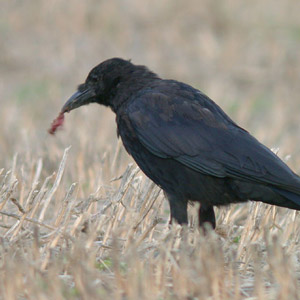Pratique | Débuter
Le cerveau et l’intelligence des oiseaux

La Corneille noire (Corvus corone) et les autres corvidés ont des capacités d’adaptation et d’apprentissage remarquables.
Photographie : Joël Bruezière / Eyesonsky.com
Introduction
Dans le langage populaire, les insultes comme »cervelle d’oiseau » ou »drôle d’oiseau » contribuent à ancrer l’idée que ces animaux sont de petits êtres légers et simples. Mais idem en science, estime une équipe de chercheurs, qui propose une nouvelle nomenclature pour désigner l’anatomie des cerveaux d’oiseaux et pour en finir avec les préjugés.
Les exemples de comportements complexes et de formes d’intelligence sont nombreux. Le Corbeau calédonien (Corvus moneduloides) fabrique par exemple ses outils pour attraper sa nourriture, comme un primate prend une brindille pour attraper les termites.
Dans cet article, nous vous proposons une présentation de la structure du cerveau des oiseaux (nomenclatures classiques et nouvelles), une approche de son fonctionnement, et une évocation de la proportion de l’intelligence et des comportements instinctifs chez nos amis ailés.
Abstract
Like all animals, birds need a control centre and a set of communication channels to ensure that there system runs smoothly. As in most more complicated animals this is usually called a brain and a nervous system. Birds have a similar basic plan to their nervous system as the rest of the vertebrates.
The brain of a bird weighs about 10 times as much as a brain of a reptile of the same weight, but slightly less than that of a mammal of the same weight. However, there is considerable variation between birds of similar size. There is therefore quite a range in the intelligence of birds, with game birds at the bottom of the list and Woodpeckers, Owls and Parrots at the top.
A bird’s brain is different to a mammalian brain in that the complex folds found in the cerebral cortex of mammals are missing and the cerebral cortex itself is much smaller proportionally than in mammals. Instead the corpora striata, a more basic part of the cerebral hemispheres is proportionally larger and better developed. It is this portion of a bird’s brain which is used to control instinctive behaviour – feeding, flying, reproduction etc. The mid-brain is also well developed as this is the part of the brain primarily concerned with sight, while the olfactory lobes are reduced as would be expected given that bird’s in general have little use of the sense of smell.
Beside this description of the brain of birds and the way it works, we will discuss about their intelligence : the respective places of instinct and reflexion in their life, their ability to learn and to recall are some of the subjects we will speak about.
Poursuivez la lecture de cet article, en vous abonnant dès maintenant !
Découvrez les Archives d’Ornithomedia.com
Pour seulement 10,00 €TTC/an (ou 6,00 € les 6 mois)
Profitez de plusieurs centaines d’articles en accès illimité et sans aucun engagement.
Compléments
Ouvrages recommandés
- The Minds of Birds de Alexander F. Skutch, Dana Gardner
- Bird Brains: The Intelligence of Crows, Ravens, Magpies, and Jays de Candace C. Savage
- Quel est donc cet oiseau ? de Walter Cerny, Karel
- Le Guide Ornitho de L. Svensson et al.





Aucun commentaire sur ce sujet
Participer à la discussion !